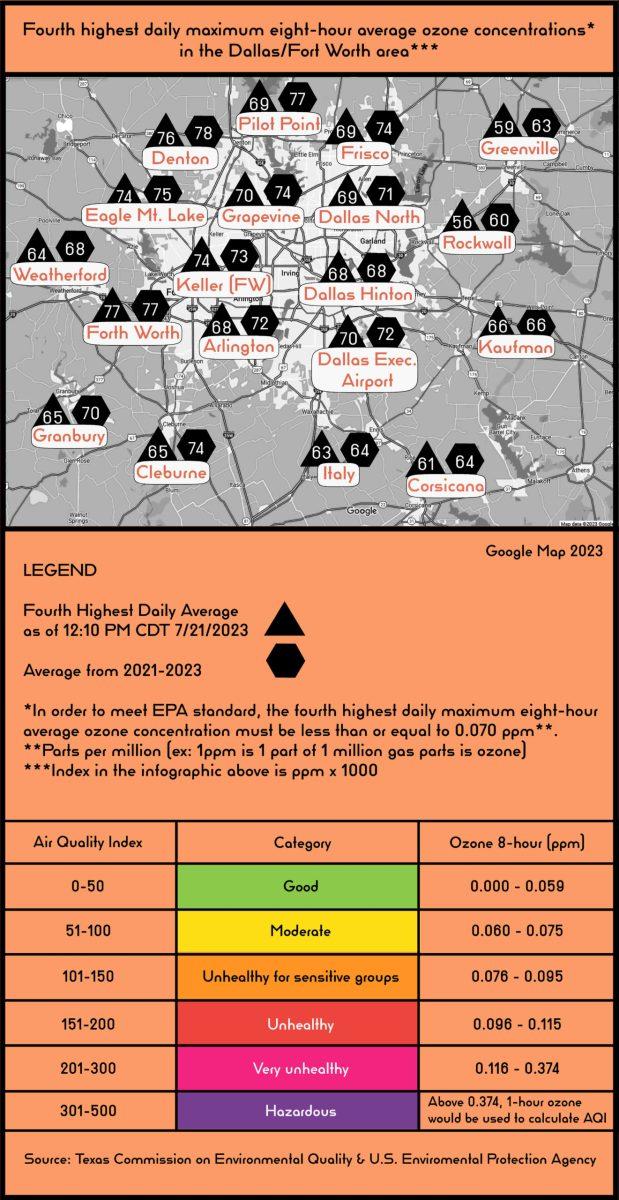The Dallas Fort-Worth Metroplex has been facing intense heat waves and poor air quality partially due to Canadian wildfires that began in March, putting residents at risk for heat-related illnesses and poor air quality symptoms.
The mass wildfires in Canada that started earlier this year had already been ongoing for three months due to natural causes before 20 northeastern states were plunged into a yellow fog of pollutants on June 7. Smoke from a burning Quebec drifted across the border, shutting down countless flights, schools, and businesses as the worst air quality in the world was recorded just above New York City at 158 Air Quality Index. For reference, between 51 and 100 is a moderate AQI score. Dangerous air quality alerts continued until July 1, with smoke clouds even reaching Western Europe, before a second wave of alerts reactivated July 17. Both domestic and international firefighters have responded as the crisis persists and became the largest wildfire in modern North American history. The ecological damages continue to be a concern and far-reaching even in DFW, where a recent study presented that wildfires can be damaging to the ozone layer.
Jenny Narvaez, program manager for air quality management at the North Central Texas Council of Governments, points out that DFW has had a history of bad air quality. While there are already programs improving the situation, wildfires of this scale can make air quality dramatically worse and create a health hazard.
“We’ve been in non-attainment for ozone since the early 90s. Largely, mostly due to our meteorological placement,” Narvaez said. “The impacts of any type of [wildfire] event would affect the rise in particulate matter.”
Between June 7 and July 21, Dallas has had only seven days of “good” – or moderate – air quality, with 11 of those days connecting particulate matter such as dust, dirt, soot or smoke as the primary pollutant of concern, according to the Texas Commissions for Environmental Quality. Consistent exposure to poor air quality has been linked to eye irritation, trouble breathing and lung cancer according to the CDC.
The ozone layer is a region in the Earth’s stratosphere most responsible for absorbing the Sun’s ultraviolet radiation. Without the ozone layer, life on Earth could not be sustained. The ozone layer can be damaged through specific pollutants like those found in the smoke of wildfires, thinning the protective barrier between life on Earth and the heat of the Sun, as well aspreventing the ozone layer’s natural recovery process. This excess heat also gradually increases the toxicity of ground level ozone formulated primarily by gas emissions. Currently, Texas is on track for one of the hottest summers in its history, which was last recorded in 1994 with 26 consecutive days of over 100 degrees.
For the most part, DFW has not seen fully smoky skies from the Canadian wildfires, but that does not mean its impacts aren’t far-reaching. An analysis by the National Oceanic and Atmospheric Administration found that in the 2022 wildfire season, Canadian and western United States wildfires had global impacts on the ozone layer, attributed to rising heat and pollutant emissions. Both of these wildfires were a combined total of 3.1 million acres in size. The current wildfire in Canada alone is 27.11 million acres large as of July 19, which is over 3,200times larger than the current wildfires in California, and its impact will be on a scale never before seen in the United States.
As a part of the rising heat, the state of Texas is one of a few south central states trapped in a heat dome, which occurs when high pressure circulation of the atmosphere traps and intensifies heat. States trapped in heat domes will experience longer durations and more intensified heat. During this time, heat-related illnesses are more likely to occur, such as heat strokes, heat exhaustion and sunburns. According to the Dallas County Health and Human Services, nearly 617 heat-related illnesses have been reported in Dallas hospitals, a sharp 30% increase in expected numbers.
Christian Grisales, the public information officer for Dallas County Health and Human Services who reported on heat related hospitalization, advises to keep medical consequences in mind.
“It’s very important to monitor your symptoms, to hydrate constantly and to stay indoors if possible; just to do everything we can because this heat has been terrible for all of us,” Grisales said to CBS News.
For those unsure about air quality of their city or heat-related dangers, Narvaez recommends students stay in tune to the weather station or with Air North Texas, a partner of UTD.





